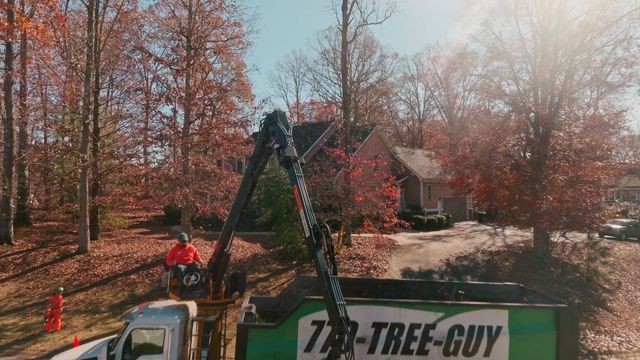
Atlanta, Georgia, known as the "city in a forest," is renowned for its lush tree canopy. Trees not only enhance the beauty of the metro area but also provide numerous environmental benefits such as improving air quality, reducing noise pollution, and offering shade during hot summer days. To ensure the health and longevity of Metro Atlanta Tree Service, proper maintenance is essential. Here are 10 essential tips for maintaining trees in the region:
1. Regularly Inspect Your Trees
Regular inspections help identify any potential issues with your trees early on, allowing for prompt action to be taken. Look for signs of disease, pest infestations, dead branches, and overall tree health.
Key points to consider during tree inspections:
- Check for any cracks or splits in the trunk or branches.
- Inspect the leaves for discoloration, spots, or unusual patterns.
- Look for signs of pest activity such as holes in the bark or sawdust around the base of the tree.
2. Properly Water Your Trees
Proper watering is crucial for the health of your trees, especially during dry periods. Make sure to water deeply and infrequently to encourage deep root growth.
Tips for watering trees effectively:
- Water trees at the base, avoiding wetting the foliage.
- Use a slow drip or trickle irrigation system for deep watering.
- Adjust watering frequency based on weather conditions and soil moisture levels.
3. Mulch Your Trees
Applying mulch around the base of your trees helps retain moisture, suppress weeds, and improve soil health. Mulch also acts as an insulator, protecting the tree roots from extreme temperatures.
Tips for mulching trees:
- Apply 2-4 inches of mulch around the base of the tree, keeping it away from the trunk.
- Use organic mulch such as wood chips or shredded bark.
- Refresh the mulch layer annually to maintain its effectiveness.
4. Prune Your Trees Regularly
Pruning helps maintain the structure and health of your trees by removing dead, diseased, or crossing branches. Proper pruning also promotes air circulation and sunlight penetration throughout the tree canopy.
Guidelines for tree pruning:
- Prune during the dormant season to minimize stress on the tree.
- Use sharp and clean pruning tools to make precise cuts.
- Consult with a professional arborist for complex pruning tasks.
5. Protect Trees from Construction Damage
Construction activities can harm trees by compacting soil, damaging roots, or causing physical injuries. Implementing tree protection measures during construction projects is crucial to preserving the health and stability of trees.
Ways to protect trees during construction:
- Create tree protection zones with fencing or barriers to prevent equipment damage.
- Minimize soil compaction by avoiding heavy machinery near tree roots.
- Consult with an arborist before construction to develop a tree protection plan.
6. Monitor Tree Health Throughout the Year
Monitoring the health of your trees year-round allows you to address potential issues promptly and ensure the overall well-being of your trees. Keep an eye out for changes in leaf color, foliage density, and overall growth.
Tips for monitoring tree health:
- Keep a gardening journal to track changes in tree health over time.
- Observe for signs of stress such as wilting leaves or premature leaf drop.
- Seek professional help if you notice persistent issues with your trees.
7. Fertilize Trees Appropriately
Applying the right type and amount of fertilizer can enhance the growth and vitality of your trees. However, over-fertilization can harm trees, so it's essential to follow proper fertilization guidelines.
Guidelines for tree fertilization:
- Perform a soil test to determine the specific nutrient needs of your trees.
- Apply fertilizer in the root zone of the tree, spreading it evenly around the drip line.
- Avoid fertilizing trees during drought or extreme weather conditions.
8. Address Tree Issues Promptly
If you notice any signs of tree stress, disease, or pest infestation, it's crucial to address the issues promptly to prevent further damage. Delaying treatment can lead to irreversible harm to your trees.
Common tree issues to watch for:
- Leaf discoloration or unusual spots.
- Unexplained wilting or drooping of branches.
- Premature leaf drop or dieback in the canopy.
9. Hire a Professional Arborist for Tree Care
When in doubt about the health or maintenance needs of your trees, consider hiring a certified arborist. Arborists are tree care specialists who can provide expert advice, diagnosis, and treatment for your trees.
Benefits of hiring an arborist:
- Professional assessment of tree health and maintenance needs.
- Expert pruning, fertilization, and pest management services.
- Access to specialized equipment and techniques for tree care.
10. Stay Informed About Local Tree Regulations
Being aware of local tree regulations and ordinances in Metro Atlanta is essential to avoid potential fines or penalties for improper tree maintenance or removal. Familiarize yourself with the rules governing tree care in your area.
Key points about local tree regulations:
- Check with your city or county government for tree preservation guidelines.
- Obtain permits for tree removal or major pruning activities when required.
- Consult with local authorities or arborists for guidance on tree care compliance.
By following these 10 essential tips for maintaining trees in Metro Atlanta, you can help ensure the health, beauty, and longevity of the urban forest in the region. Proper tree care not only benefits individual property owners but also contributes to the overall environmental sustainability and quality of life in the city.
